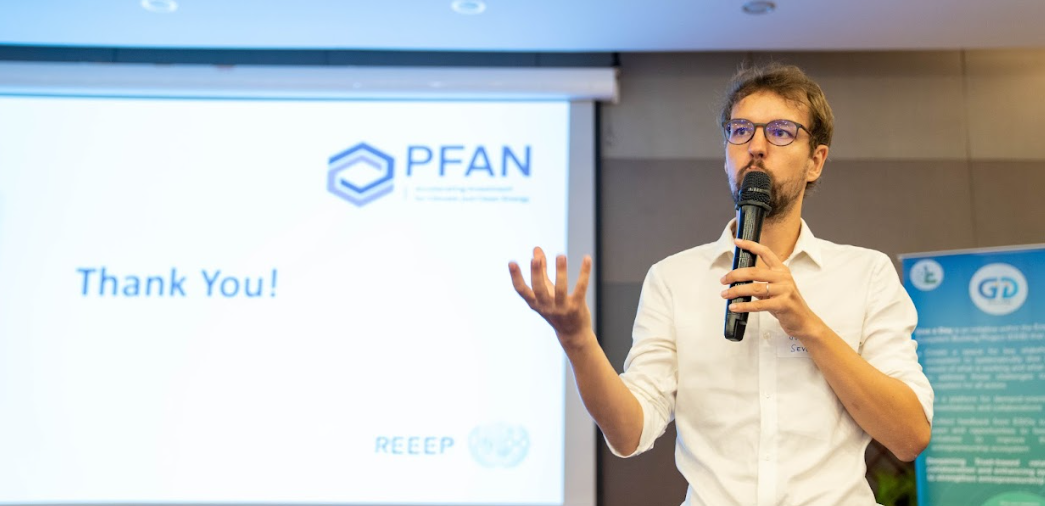Josh Downs
The monthly Give a Day program held its sixth installment of the Entrepreneurship Ecosystem Building Project (EBBP) under the topic ‘Leveraging Collaborative Approach to Support Entrepreneurs in Accessing Investment’.
Give A Day is funded by Khmer Enterprise and implemented by USAID’s WE Act Project through Pact Cambodia and Swisscontact.
To read CIR Leader Talks with Khmer Enterprise CEO Dr. Chhieng Vanmunin click here.
A consensus from Cambodia’s Entrepreneurial Support Organisations (ESO) was that a lack of common language around investment readiness between investors and entrepreneurs often led to a mismatched expectation between demand and supply of capital providers.
Recently, however, intermediaries such as investment brokers are starting to narrow this gap.

One such individual is Guillaume Requin, Head of the SMEs and Finance department at Sevea. Guillaume has been supporting innovators and entrepreneurs in multiple industries, such as healthcare, agriculture, forestry, and nano-technologies.
He explained to Cambodia Investment Review the challenges faced in Cambodia’s entrepreneurial landscape when it comes to connecting innovation with funding.
“The first challenge is sourcing good projects, especially those run by Cambodian entrepreneurs. There are really good, high-potential projects out there, there is simply a lack of awareness and effective marketing to connect the channels.
The second challenge is a lack of proper financial structure and planning in these small businesses, which makes it extremely difficult to gauge the likelihood of success. There are only really a few projects that meet industry standards.”
Improving financial management
Requin also highlighted the negative impact of poor financial management on investor feasibility and confidence.
“Our purpose is to build the best investment structure for investors, but many small operational businesses don’t keep balance sheets, accounting records, or profit and loss records.
This makes it difficult to determine the type and value of the investment they should be applying for, and we must work with them to develop these competencies.
To read more about Seva and PFAN in Cambodia click here.

Overall, Cambodia is still seen as a risky market to foreign investors, but things are slowly getting better. The new reforms to investment law and the continued efforts of ESOs are really making a difference.”
Requin introduced the Private Financing Advisory Network (PFAN), which supported over 750 low-carbon and climate-resilient projects/businesses in developing countries since 2006, raising over $2 Billion in financing to date for over 176 projects.
They believe that enhanced collaboration with ESOs, such as those at the Give a Day event, will heighten the success rate of ventures by meeting investor standards.
SMEs face challenges to scale their business
Another prominent figure in Cambodia’s impact investment landscape is Nathan Polley. Nathan is the Academy Lead for Mission Alliance Business Development, an organization that prepares entrepreneurs and innovators for international investment.
He explained the concept of the ‘missing middle’ to Cambodia Investment Review – a result of micro and small businesses not being able to scale.
“If you look at Cambodia, there’s a huge number of micro-businesses – think coffee stands, street food vendors – then there is a smaller number of small businesses. There is also a number of big companies and corporations, but when you look to the middle, there’s virtually nothing.
To read more about Cambodia’s ‘missing middle’ of investment click here.

In other countries, the middle is usually populated by small businesses that have matured into that size, but here in Cambodia, it is quite difficult for businesses to scale.
We believe this is caused by four key reasons – barriers that limit access to capital, a lack of business or technical competence, limited networks and broken value chains.
We work to address these by connecting Cambodian businesses with our international partners who can offer investment, insights and market access”.
Middle-size companies are characterized by professional and technical management such as project managers and HR specialists which, as Nathan notes, is still being developed in Cambodia.
“Cambodia is still building its business capacities in terms of education. This isn’t limited to just academic subjects, but general business and finance acumen also.
As the next generation of Cambodian business leaders emerges, there will be more structure and scale in these micro-businesses which will then help foster further economic development within Cambodian communities”.





